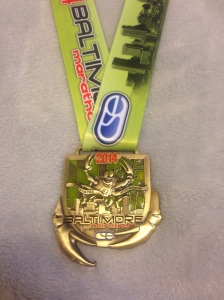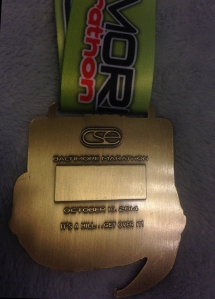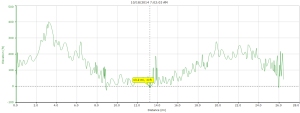Going into this race, I felt like I had a pretty good idea of what to expect. I did my homework. I ran four 20-milers and a 22. I ran hills. I studied the course as much as I could and visualized the race. The week before, I figured out all of my splits based on the elevation profile. I was sure I knew was I was in for. I was completely wrong.
Race morning we arrived at the stadium about an hour and half before gun time. We parked, located the baggage drop-off, found the bathrooms—real ones!—in Camden Yards, and then I did a few warm-up strides to try to shake off my nerves. I had slept badly the night before and had gotten maybe 3 hours or so, but still felt alert and ready to go. With only 2,700 marathoners, there were no formal corral assignments—just signs denoting min/mile paces. The Caveboy and I positioned ourselves at the back of the 8’s/front of the 9’s, and after the usual prerace fanfare we were off. I knew that the first three miles were uphill, so I tried to focus on calming my nerves and settling into a nice 9:15-9:20 pace, figuring I’d make it up on the long downhill to come. From the start, pacing turned out to be a lot more difficult than I’d imagined. What had looked like a long, slow grade on the elevation profile was in fact continuously rolling terrain. We’d run up a 30’ rise, hit a very short downhill and lose 15’ of gain, then run up and down again. We were definitely climing overall, but the short hills were much harder to pace properly than a gradual slope would have been. The downhills weren’t long enough to really open up, and by the time I’d get a good turnover going I’d realize we were already heading uphill again and I was running a suicidal 8:10.
We continued in this fashion until we got to the zoo—a recent course addition—which was probably my favorite stretch of the whole thing. There were more hills there, including some steep and twisty downs, but the course itself was quite pretty. The sun had come up fully by then, and zookeepers were posted along the route holding a raven, an oriel, and—by the time the Caveboy got there—a baby penguin. The real challenge through those miles, in addition to the continual hills, was the number of turns. The pack was still reasonably crowded and the pace would lag on every uphill and turn. I was having a hard time holding anything close to my 8:50 pace even on the downhills, and starting to get worried.
Finally, the long downhill stretch began, or so I thought. Again, it turned out to be much more of a rolling net downhill, and I was already starting to struggle with my mind going negative. As much as I tried to relax, to just let the nervousness be there and not worry about it, I just could not tune out and run. In retrospect, I think that had a lot more to do with the course than I realized at the time. Until this race, I really never realized how much I count on being able to lock in a pace and tune out. At the time, though, I hadn’t quite realized how the terrain was affecting me and instead I further beat myself up for not being able to relax. By the time we got to the first semi-flat section at the Inner Harbor, I knew I was in trouble. I was running 9’s and working hard to hold them. At the water station around 11 I was passed by the 4-hour pace group, and decided to hang with them for a few miles while I figured out the plan. I was going to a very dark place and I knew I needed to pull it together if I was going to get through the rest of the race. I stayed with the pace group for five or six miles and just tried to focus on breathing out the side stitch that had been nagging since the start. The four-hour group was running inexplicably fast—8:30’s it seemed—and I ended up falling behind them at an aid station past the halfway point. We were back into the hills and the longest climb of the race by that point, and I really didn’t have it in me to surge to catch them again. To add to the difficulty, it was getting warmer and there was no protection from the sun on the second half of the course.
Letting the pace group go actually helped a bit mentally—I made my peace with not breaking four hours and actually was able to relax a little bit. The half marathoners joined us at mile 16, and the influx of energy was nice as well. Though the course was now more crowded, most of the halfers were still running the uphills at a decent pace, so I tried to hang with them and ignore the increasing numbers of marathoners who were now walking. With about 7 miles left, the side stitch I’d been fighting for most of the race was really starting to hurt, and I worried that if it cramped completely I wouldn’t be able to breathe or finish faster than a walk. I finally gave in a walked a bit of the next uphill and felt a bit better after that. The downhills actually hurt it worse than the ups, I think just due to the impact, so I kept trying to keep up a 9:30ish pace for as much of the uphills as I could and then walk fast as briefly as necessary.
Over the next several miles of climb I had never wanted to stop running so badly in my life, but the weird thing was that my legs still felt pretty good and I really wasn’t running all that slowly. The mental fatigue of the impossible uphill-downhill pacing, not to mention the race nerves had me completely worn out, though. Miles 20-21 were a mercifully flat loop around Lake Montebello. A lot of the runners around me groaned when they saw it, mostly because it’s one of the few spots in the race flat enough to actually see a large expanse of the course in front of you. The two-mile string of runners threading around the lake looked impossibly long, and we all knew that it was only a small portion of the distance still left to run. I, however, felt nothing but a flat, grim resolve. Strangely, at no point during the race did I ever think about how many miles were left, or whether I’d be able to run them. I also never once worried about getting through the ‘unknown’ miles 22-26, which I can’t really explain. While the nervous part of my brain was running wild during the race, the emotional part seemed completely gone by that point. I counted every breath the whole way around that lake, and thankfully, had at least two flat miles to lock in a pace and zone out a bit.
After a lot more hills, finally, FINALLY, we hit the last downhill at mile 24. I tried to pick up the pace as much as I could and managed to hit mid to high 8’s. By this point, though, so many people were walking that I had to dodge and weave just to maintain steady progress. The crowds got denser as we neared the stadiums, and finally we were headed for the finish line. The mile 26 marker must have fallen over; I never saw it. I just kept grimly running, trying to keep my form and knowing that if I kept it up long enough it would eventually end. Before the race, I had worried that I’d get so emotional heading to the finish line and that it might be hard to breathe or run hard. In the end, I felt nothing at all. For the last half mile, I just kept running, putting one foot in front of the other until it was over. There was no emotion, no sense of accomplishment, just a muted relief at being able to stop.
My final time was 4:08:43. I wasn’t as disappointed initially as I might have been since I knew I absolutely could not have prepared better or run harder. When I checked the results—the bibs had a QR tag that allowed you to get your results within 10 minutes of finishing—I was a little shocked, though. I had finished in the top quarter of women, the top third overall, and the top 50 in my age group. When I saw the numbers, I recalibrated a bit and considered that I might possibly have done pretty well.
All in all, I’m still not really sure what to make of it. The course was not at all what I expected. Still, the hills really got me mentally more than physically. I learned a lot, including just how mental this sport really is. I also learned to scout the course in person well ahead of time. When I consider the full experience of training and racing, it was totally worth it. Still, I’m surprised at how flat I felt at the finish. I will do another marathon, but I’m not sure if it will be in a few months, or a year. I know I need to let my body recover from what’s been nearly a solid year of racing and training, but I HATE that I can’t run for a few more days. Part of me can’t imagine doing it all over again, but I’m already reading Running on Air to learn how to breathe more efficiently (and hopefully eliminate those nagging side stitches), and thinking how to train better next time. Mostly, though, I’m sad that it’s over. I should probably mention that I’ve gone off coffee for a week while I recover from the race, so this may all be the lack of caffeine talking.






